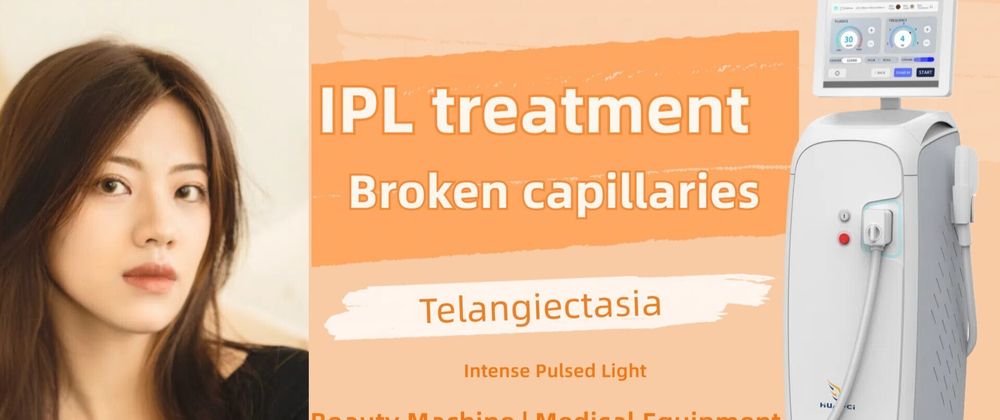A guide to parameters for treating telangiectasia with intense pulsed light and an introduction to the principles of IPL treatment for broken capillaries.
Article source:https://www.litonlaser.com/ipl-treatment-for-broken-capillaries/
Facial redness is also known as “facial telangiectasia”, which is what we often call “highland red” and “red face”. It is the result of long-term and continuous expansion of facial capillaries. This skin is thin and sensitive, and the face becomes redder when it is too cold, too hot, emotional or the temperature changes suddenly. In clinical practice, we often use intense pulsed light to treat telangiectasia, which can also be called IPL treatment for broken capillaries.
What principle is this based on? During treatment, how should it be operated to achieve better results?
- Clinical manifestations and pathogenesis of telangiectasia. Facial telangiectasia is a skin vascular disease, characterized by facial redness and visible telangiectasia, which is often red, purple or blue-purple. According to the appearance of the dilated blood vessels, telangiectasia can be divided into dot-shaped, linear, dendritic and papular forms, and often occurs on the face, especially the nose, middle cheek and chin. The diameter of the dilated blood vessels ranges from 0.1 to 1.0 mm, representing dilated venules, capillaries or arterioles.
Three common types of facial telangiectasia
The etiology of facial telangiectasia is complex and can be roughly divided into primary and secondary. Primary telangiectasia is often accompanied by familial inheritance. Genetics determine that the skin has a thin stratum corneum and capillary vasodilation defects under congenital conditions, so that the blood vessels cannot dilate and contract. Secondary telangiectasia is the most common, and generally occurs when hormone drugs are used, blood circulation is blocked, excessive exfoliation, sensitive skin, etc. Such as plateau redness, facial flushing, inflammatory redness, etc.
- Treatment methods for telangiectasia. Even in healthy people, telangiectasia is common.
Clinical treatments for facial telangiectasia include topical medications, systemic medications, laser therapy, sclerotherapy, and electrosurgery, but with the development of medical aesthetics, photoelectric therapy has gradually become a conventional method for treating red blood streaks due to its advantages of short recovery period and good results.
According to the “Guidelines for the Diagnosis and Treatment of Common Diseases Related to Laser Beauty (2024 Edition)”, photoelectric therapy is currently the preferred method for the treatment of telangiectasia in clinical practice. It can be roughly divided into selective and non-selective. Selective photoelectric therapy includes pulse dye laser, long pulse width YAG laser, KTP laser, diode laser, intense pulsed light, etc.; non-selective photoelectric therapy includes CO2 laser, argon laser, etc. The overall effective rate of photoelectric therapy is 53.3%~100%.
- Introduction to Intense Pulsed Light. IPL (Intense Pulsed Light) is a high-intensity, wide-spectrum pulsed light source, and the wavelength of the light it emits is usually between 400nm-1200nm.
Its aliases include: photon, strong light, color light, intense pulsed light, E-light, OPT, SHR, DPL, AOPT, etc. Since photons cover a wide spectrum range, almost all important skin target tissues (melanin, hemoglobin, water), so the skin beauty effect of IPL is very extensive.
The characteristic of the IPL machine is the selective absorption of light, which belongs to the photothermal effect. For the problem of capillaries, the photothermal effect can be used to heat the capillaries to shrink them, thereby realizing IPL treatment of capillary damage.
- The principle of IPL treatment for broken capillaries. Intense pulsed light uses photothermal coagulation. Based on the principle of selective photothermal action, oxygenated hemoglobin can selectively absorb full-wavelength strong light of a specific wavelength, causing hemoglobin to coagulate and achieve the purpose of treating capillary dilation. Oxygenated hemoglobin has a higher absorption rate near the wavelength of 500nm to 600nm. The highest peak of melanocyte absorption is in the ultraviolet light range (240nm to 360nm), and the skin’s absorption of light and heat is mainly determined by skin pigment cells. Therefore, as long as the appropriate tissue depth is reached during the treatment process and the correct wavelength is used, the dilated capillaries can be treated.
A study selected 144 patients with facial telangiectasia and divided them into a control group and an observation group according to the random number method, with 72 cases in each group. Among them, the control group patients received systemic drug treatment (medical skin care products rich in vitamin K1 and mushroom glucose Winona Shuyan Anti-Redness Repair Cream, applied on the face, used continuously for one month, used every night after cleansing, with a dosage of 0.1ml/cm2), and the observation group patients received relevant treatment with a photon skin rejuvenation instrument to observe the treatment effects of the two groups of patients.
Clinical data showed that the total effective rate of the observation group treated with intense pulsed light was 100%, much higher than that of the systemic drug treatment group.
- Parameter guidance for intense pulsed light treatment of telangiectasia. According to the “Guidelines for the diagnosis and treatment of common diseases related to laser beauty (2024 edition)”, the energy density, number of sub-pulses, pulse width of sub-pulses and delay of sub-pulses of intense pulsed light vary from device to device and individual.
5.1 M22 beauty machine for the treatment of capillary damage.
Intense pulsed light (M22, Lumenis, USA) filter wavelength 560, 590 nm, energy density 16~20 J/cm2, 2 sub-pulses, pulse width 3.0~6.0ms and 5.0~8.0ms respectively, delay 20~40 ms, treatment interval 4 weeks, 3~5 times or more treatment. Deeper blood vessels can also choose 560, 590nm wavelength combined with longer wavelength (615, 695 nm) for treatment. Or choose Vascular dual-wave filter, band 1 530~650 nm, band 2 900~1 200nm, energy density 16~20 J/cm2, 2 sub-pulses, pulse widths 4~5ms and 6~7ms, energy densities 10~12J/cm2 and 8~10 J/cm2, delay 20~40ms, treatment interval 3~4 weeks, 3~5 treatments.
5.2 Alma Beauty DPL machine for treating telangiectasia.
Intense pulsed light (DPL, Alma, Israel) Choose a special handpiece for treating telangiectasia, wavelength 500~600 nm, spot area 10mmx3mm. Fixed-point treatment mode: pulse width 10~12 ms, energy density 9~12 J/cm², 10% overlap, cooling gear 50%~75%, irradiation 1~2 rounds, treatment interval 4 weeks, 3~6 treatments.
5.3 Litonlaser beauty machine IPL treatment of capillary damage.
As a beauty machine manufacturer with 20 years of experience, Litonlaser has very successful data on the research and treatment of IPL machines. It can use a 560nm vascular handle with a wavelength of 560~1200nm and a spot area of 10mm*45mm. The pulse width is 10ms and the energy density is 12J/cm². Set three sub-pulses with a pulse interval of 2ms. Irradiate the entire face for 3 rounds, treat once a month, and continue for three months to effectively improve.
- Key points of IPL treatment of capillary damage.
Intense pulsed light can be used as the preferred treatment for shallow capillary dilation of the skin. For thicker capillaries, pulse dye laser treatment is the first choice, but adverse reactions such as swelling or purpura may occur. Usually, purpura will occur when a shorter pulse width is used for treatment, while purpura is less likely to occur when a longer pulse width and lower energy are used.
When using intense pulsed light to treat red blood streaks, people with lighter skin color should choose a shorter wavelength (such as 560nm), and people with darker skin color should choose a longer wavelength (such as 590nm). For blood vessels with large diameters, a long pulse width is selected, and the end-point reaction of the treatment is an immediate deepening of the blood vessel color; for small blood vessels, a shorter pulse width is selected, and the end-point reaction of the treatment is blurred edges or even disappearance of the blood vessel.
During treatment, the instantaneous changes of the blood vessels after absorbing energy should be carefully observed, which is crucial to determine whether repeated treatment is needed. During the treatment process, it is not advisable to repeatedly irradiate the energy from low to high gradually.
FAQ about intense pulsed light reducing telangiectasia.
Q: Which laser is best for broken capillaries?
A: If the capillaries are small, IPL is the best. If the capillaries are large, pulsed fuel laser is the most effective laser for improving capillary dilation.
Q: Which is better, IPL vs PDL for broken capillaries?
A: IPL mainly uses a handle with a wavelength of 650nm to 1200nm for broken capillaries, while DPL uses a handle with a wavelength range of 500nm to 600nm. From the perspective of treatment effect, DPL is better for improving broken capillaries, but the price is also higher.
Q: What facial treatment is best for broken capillaries?
A: To solve the problem of broken capillaries on the face, we can use drug treatment and photoelectric treatment. Photoelectric treatment is often more effective. If the capillaries are small, it is best to use IPL intense pulsed light treatment.
Q: How long does it take to treat capillary dilation with IPL?
A: Usually treatment is required once a month. After 3 to 6 months, capillary dilation can be significantly improved and facial redness will be largely reduced.
- More about IPL beauty machines and treatment options for telangiectasia. If you want to master more operating skills about photoelectric treatment or want to systematically learn the relevant knowledge of skin diagnosis and treatment, our litonlaser beauty technology training center can provide you with high-quality and complete photoelectric beauty core technology training courses.
If you are a dealer or a beauty salon manager and need to buy high-quality IPL beauty machines, you can contact us at any time. We have 20 years of experience in beauty machine production. For IPL machines, we can produce the first one as early as 2007, and now we have countless customers around the world.
If you are interested, please contact us:20 years of experience in medical beauty machine manufacturer.




Top comments (0)